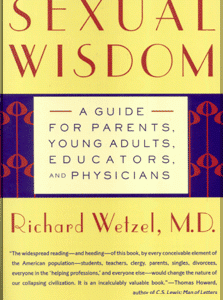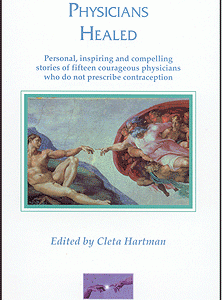Synopsis
Double quotes here are used to show text taken directly from the encyclical. Numbers in parentheses are section numbers of the encyclical.
God’s love for us and our response (love for God and others) sums up well the Christian faith and also the destiny of all humans. The word “love” can have many meanings. Love as “eros” is used to mean all the spontaneous human passions, emotions, and attractions that contribute to love. Love as “agape” refers to self-sacrificing love that desires only the good of the beloved. Man is made up of body and soul, so a full, truly human love requires a proper balance of both eros and agape. (1-8)
Revelation in the Bible adds depth to our understanding of love in several ways. The Old Testament presents God to us as loving His people with a marital, erotic love and with wholehearted devotion as well. Also in the Old Testament, man is portrayed as incomplete without a mate, without someone to love and be loved by. Man’s drive to fill this incompleteness, a drive we call “eros,” directs him toward a love which is definitive and unique, that is marriage, the very relationship which God has entered with His people. (9-11)
The New Testament introduces us to the person of Jesus, who embodies “love in its most radical form.” Jesus made His love accessible in an enduring way by instituting the Eucharist. The Eucharist unites participants to Jesus’ own love, and, by its social character, also commits them to love for all who participate and, according to Jesus’ teaching, for all who are in need. (12-15)
Through Jesus Himself, through the Eucharist, and through many other avenues, God makes His love visible to us. He then commands us to love others. His own love, which we have experienced, empowers us to obey this command. The members of the Church, due to God’s love present within them, are constantly pressed to care, like God, for the whole range of other people’s needs, including material needs. (16-18)
Love in action is the direct result of the life of God in the hearts of His people. Practical service to the needy has been a key aspect of Christian community life from the very beginning, and throughout Church history to the present. “The Church’s deepest nature is expressed in her threefold responsibility: of proclaiming the word of God (kerygma-martyria), celebrating the sacraments (leitourgia), and exercising the ministry of charity (diakonia). These duties presuppose each other and are inseparable. For the Church, charity is not a kind of welfare activity which could equally well be left to others, but is a part of her nature, an indispensable expression of her very being.” This service is directed first to members of the community, but includes all others as well. (19-25)
An objection has been raised, especially by Marxism, that works of charity damage the poor because they reduce their suffering, and the poor need the incentive of that suffering to rise up and bring about justice. This objection is misleading, because we cannot do good for future people by failing to do good for people who exist. (26, 31b)
In response to this challenge and to various crises, however, the Church has come to see charity in terms of reforming social structures as well as helping individuals. The Church faces a special challenge in this because, by her nature, she must not take on the activities of a secular state. The Church remains always in the role of an advisor, but an absolutely essential advisor. Through her teaching role, the Church enables the states to achieve true justice. (27-28a)
However, justice is not enough. There is always need for personal concern, driven by genuine compassion, and the state is incapable of supplying this need. The Church has an eminent role in filling this need. The Church’s lay faithful, however, have the direct responsibility of entering into and building a just society, and their political activities must be informed and moved by love. (28b-29)
Improved communication has made people much more aware of needs throughout the world, and many very effective state agencies and humanitarian organizations have developed which address these needs. The Church has developed many forms of fruitful collaboration with these initiatives, and with other Churches and Ecclesial Communities who work toward these same goals. (30)
This circumstance raises the need for the Church to clearly identify the special characteristics that identify organized Christian charitable activity. It is, “first of all the simple response to immediate needs and specific situations; feeding the hungry, clothing the naked, caring for and healing the sick, visiting those in prison, etc. . . . Yet, . . . human beings always need something more than technically proper care. They need humanity. They need heartfelt concern. . . . Consequently, in addition to their necessary professional training, these charity workers need a `formation of the heart’ . . .Christian charitable activity must [also] be independent of parties and ideologies. . . . the program of Jesusis `a heart which sees’. This heart sees where love is needed and acts accordingly. . . . Charity, furthermore, cannot be used as a means of engaging in . . . proselytism. Love is free; . . . A Christian knows when it is time to speak of God and when it is better to say nothing and to let love alone speak.” (31)
Bishops have the primary responsibility for seeing that the Church’s charitable responsibilities are fulfilled. All who participate in the Church’s charitable work are responsible for doing it out of the love of God and not from ideology, and they are responsible for doing the work in unity with their bishop. (32-34)
Humility is needed to allow the charitable worker to avoid contempt for those being helped and to avoid discouragement at the immensity of the task. Constant prayer is also needed, especially in hard times. (35-38)
“Faith, hope and charity go together. . . . Love is the light and in the end, the only light that can always illuminate a world grown dim and give us the courage needed to keep living and working. Love is possible, and we are able to practice it because we are created in the image of God.” (39)
The saints, especially the Mother of the Lord, give us great examples of living in love, and inspire us to follow their way. In addition, they still live to help us from their place with God. Mary in particular, given to us as our mother by Jesus from the Cross, constantly fulfills her role of mother toward us, constantly helping us to grow and persevere in love. (40-42)
“Mary, Virgin and Mother, shows us what love is and whence it draws its origin and its constantly renewed power.”
Study Questions
Numbers in [square brackets] are section numbers from the encyclical. These questions are not intended to exhaust the content of the encyclical, but to provide opportunity for reflection and discussion on its principal topics.
Introduction [1]
1) What difference does it make whether a person believes or doesn’t believe that God loves him or her?
2) What is the fundamental difference between Christianity and a set of ethical rules?
PART I: The Unity of Love in Creation and in Salvation History
A problem of language [2]
3) What problems do we run into when we use the word “love”?
“Eros” and “agape” _ difference and unity [3-8]
4) Explain “eros” and “agape.”
5) Does the Church stifle or promote love? How?
6) How does love take us beyond ourselves?
7) How do body and soul collaborate in love?
8) Describe some of the stages that love goes through in becoming complete and mature.
9) How does Jesus’ sacrifice represent, “the essence of love and indeed of human life itself”?
10) How can the love that arises from our human desires and the love that descends to us from God be unified?
The newness of biblical faith [9-11]
11) What are the unique characteristics of God’s love shown in Scripture?
12) What do the creation narratives in the Bible tell us about relationships between men and women?
13) How is marriage an image of God’s love?
Jesus Christ _ the incarnate love of God [12-15]
14) How is Jesus’ death an act of love?
15) How specifically does the Eucharist unite us to God?
16) How does the Eucharist move us into loving action for one another?
17) How does New Testament teaching broaden the believer’s obligation to love?
Love of God and love of neighbor [16-18]
18) What practical help does God give the believer for carrying out the duty to love others?
19) How is this help delivered?
20) How can this duty to love others be a joy?
PART II: Caritas: The Practice of Love by the Church as a “Community of Love”
The Church’s charitable activity as a manifestation of Trinitarian love [19]
21) What does, “If you see charity, you see the Trinity” mean?
Charity as a responsibility of the Church [20-25]
22) What is the difference between the command for us to love as individuals and the command to love as a community?
23) How has this communal love been realized in the Church over the years?
24) What are “kerygma-martyria,” “leitourgia,” and “diakonia,” and why are they inseparable?
Justice and charity [26-29]
25) Why have some people asserted that justice and charity are opposed to one another?
26) What is the difference between a person being just and a society being just?
27) What problems arise when political action is not enlightened by faith?
28) What role do Church members have in building a just society?
29) What role does the Church have in building a just society?
30) What does loving personal service give to people that government organized services, in general, cannot provide?
The multiple structures of charitable service in the social context of the present day [30]
31) How has global communication changed the character of charitable work?
The distinctiveness of the Church’s charitable activity [31]
32) What “formation of the heart” is needed by workers in Christian service organizations?
33) How does this change the way the work is done?
34) Should works of charity be used as a means of adding members to the Church? Why, or why not?
Those responsible for the Church’s charitable activity [32-39]
35) What is the bishop’s role in the work of charity?
36) What interior attitudes are needed by people who do this sort of work?
37) How does prayer help develop and sustain these attitudes?
38) Faced with the massive needs in the world, how can the charitable worker have hope?
Conclusion [40-42]
39) What saints have inspired you to greater care for people in need?
40) How can you draw practical strength for service from Mary, the Mother of God?
This study guide may be copied freely, without alteration, for non-commercial purposes.







